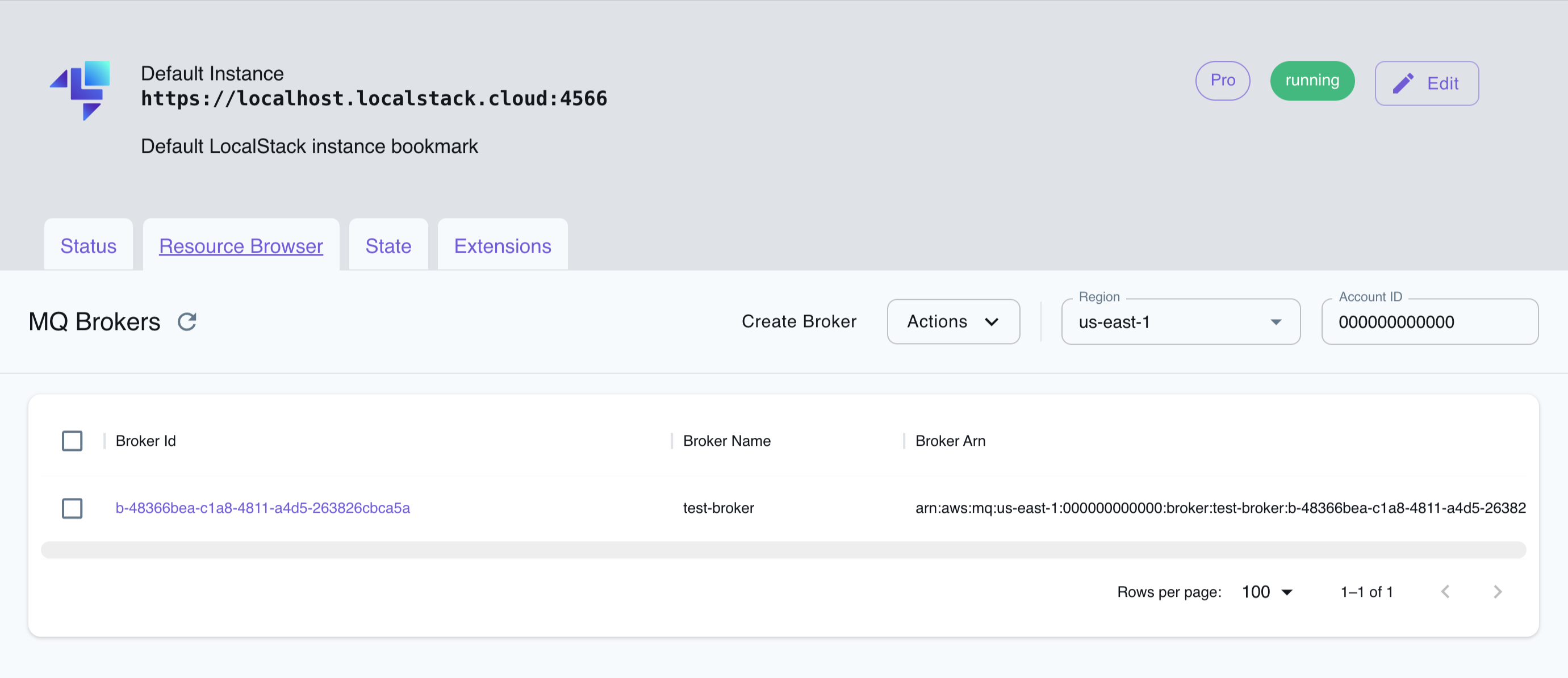MQ
Introduction
Section titled “Introduction”MQ is a managed message broker service offered by Amazon Web Services (AWS). It facilitates the exchange of messages between various components of distributed applications, enabling reliable and scalable communication. AWS MQ supports popular messaging protocols like MQTT, AMQP, and STOMP, making it suitable for a wide range of messaging use cases.
LocalStack allows you to use the MQ APIs to implement pub/sub messaging, request/response patterns, or distributed event-driven architectures in your local environment. The supported APIs are available on our API Coverage section, which provides information on the extent of MQ integration with LocalStack.
Getting started
Section titled “Getting started”This guide is designed for users new to MQ and assumes basic knowledge of the AWS CLI and our awslocal wrapper script.
Start your LocalStack container using your preferred method. We will demonstrate how to create an MQ broker and send a message to a sample queue.
Create a broker
Section titled “Create a broker”You can create a broker using the CreateBroker API.
Run the following command to create a broker named test-broker with the following configuration:
awslocal mq create-broker \ --broker-name test-broker \ --deployment-mode SINGLE_INSTANCE \ --engine-type ACTIVEMQ \ --engine-version='5.18' \ --host-instance-type 'mq.t3.micro' \ --auto-minor-version-upgrade \ --publicly-accessible \ --users='{"ConsoleAccess": true, "Groups": ["testgroup"],"Password": "QXwV*$iUM9USHnVv&!^7s3c@", "Username": "admin"}'{ "BrokerArn": "arn:aws:mq:us-east-1:000000000000:broker:test-broker:b-f503abb7-66bc-47fb-b1a9-8d8c51ef6545", "BrokerId": "b-f503abb7-66bc-47fb-b1a9-8d8c51ef6545"}Describe the broker
Section titled “Describe the broker”You can use the DescribeBroker API to get more detailed information about the broker.
Run the following command to get information about the broker we created above:
awslocal mq describe-broker --broker-id b-f503abb7-66bc-47fb-b1a9-8d8c51ef6545{ "BrokerArn": "arn:aws:mq:us-east-1:000000000000:broker:test-broker:b-f503abb7-66bc-47fb-b1a9-8d8c51ef6545", "BrokerId": "b-f503abb7-66bc-47fb-b1a9-8d8c51ef6545", "BrokerInstances": [ { "ConsoleURL": "http://localhost:4513", "Endpoints": [ "stomp://localhost:4515", "tcp://localhost:4514" ] } ], "BrokerName": "test-broker", "BrokerState": "RUNNING", "Created": "2022-10-17T07:14:21.065527Z", "DeploymentMode": "SINGLE_INSTANCE", "EngineType": "ACTIVEMQ", "HostInstanceType": "mq.t3.micro", "Tags": {}}Send a message
Section titled “Send a message”Now that the broker is actively listening, we can use curl to send a message to a sample queue.
Run the following command to send a message to the orders.input queue:
curl -XPOST -d "body=message" http://admin:admin@localhost:4513/api/message\?destination\=queue://orders.inputResource Browser
Section titled “Resource Browser”The LocalStack Web Application provides a Resource Browser for managing MQ brokers. You can access the Resource Browser by opening the LocalStack Web Application in your browser, navigating to the Resource Browser section, and then clicking on MQ under the App Integration section.

The Resource Browser allows you to perform the following actions:
- Create Broker: Create a new MQ broker by clicking on the Create Broker button and providing the required parameters.
- View Broker: View details of an existing MQ broker by clicking on the broker name.
- Delete Broker: Select the broker name and click on the Actions button followed by Remove Selected button.
Examples
Section titled “Examples”The following code snippets and sample applications provide practical examples of how to use MQ in LocalStack for various use cases:
Current Limitations
Section titled “Current Limitations”Currently, our MQ emulation offers only fundamental capabilities, and it comes with certain limitations:
- ActiveMQ Version Limitation: LocalStack pins Apache MQ 5.18 to the patched version 5.18.7. Since June 2025, 5.18 is the only supported version on AWS. RabbitMQ is not supported at this time.
- IAM User Management: IAM Users are not actively enforced, although they are necessary for making correct calls within the system.
- Configuration Enforcement: While it is feasible to create configurations, they are not actively enforced within the broker.
- Persistence and Cloud Pods: LocalStack does not provide support for Persistence and Cloud Pods at this time.
- API Coverage: Please note that there is limited API coverage available as part of the current emulation capabilities.
API Coverage
Section titled “API Coverage”| Operation ▲ | Implemented ▼ | Image | Verified on Kubernetes |
|---|